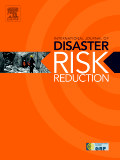
International Journal of Disaster Risk Reduction
Scope & Guideline
Fostering collaboration for a disaster-resilient world.
Introduction
Aims and Scopes
- Disaster Risk Reduction (DRR) Strategies:
The journal emphasizes the development and evaluation of effective strategies to reduce the risk of disasters, including natural hazards, through innovative practices and policies. - Community Resilience and Recovery:
Research that explores how communities can enhance their resilience to disasters, including social, economic, and infrastructural recovery strategies, is a core focus. - Interdisciplinary Approaches:
The journal encourages interdisciplinary research that integrates perspectives from environmental science, public health, sociology, economics, and urban planning to address complex disaster challenges. - Technological Innovations in Disaster Management:
The journal highlights studies on the application of new technologies, such as remote sensing, machine learning, and social media analytics, in disaster risk assessment and management. - Vulnerability and Risk Assessment:
Research examining the socio-economic and environmental factors that contribute to vulnerability and risk assessment in disaster-prone areas is a significant area of focus. - Public Health and Disaster Preparedness:
The journal addresses the intersection of public health and disaster management, exploring how health systems can prepare and respond to disasters effectively.
Trending and Emerging
- Climate Change and Disaster Resilience:
Research increasingly focuses on the impacts of climate change on disaster frequency and intensity, emphasizing the need for adaptive strategies in disaster resilience. - Community-Based Disaster Risk Management (CBDRM):
There is a rising trend in studies that advocate for community engagement and participation in disaster risk management, highlighting local knowledge and capacities. - Mental Health and Psychological Resilience:
The intersection of mental health and disaster preparedness is gaining traction, with research exploring how psychological resilience can be fostered before, during, and after disasters. - Data-Driven Decision Making:
The integration of big data and analytics in disaster management is emerging as a key area of interest, focusing on how data can inform risk assessments and response strategies. - Social Media and Communication Strategies:
Research on the role of social media in disaster communication and public engagement is trending, particularly in understanding its impact during crises. - Technological Innovations for Preparedness:
There is a growing exploration of technological solutions, including the use of drones, AI, and mobile applications, for enhancing disaster preparedness and response capabilities.
Declining or Waning
- Traditional Hazard Mitigation Approaches:
There has been a noticeable decrease in papers focusing solely on traditional hazard mitigation strategies, as the field moves towards more integrated and holistic approaches that consider social and environmental dimensions. - Single-Disaster Focus Studies:
Research papers that concentrate on single types of disasters (e.g., only earthquakes or floods) have declined, as there is a growing trend towards studying compound and cascading disasters. - Static Risk Assessment Models:
The use of static models for risk assessment has waned in favor of dynamic and adaptive models that incorporate real-time data and community feedback. - Top-Down Governance Models:
Research exploring top-down governance models in disaster management is decreasing, with a shift towards collaborative, community-based approaches that engage local stakeholders. - Historical Case Studies:
There has been a reduction in the number of historical case studies being published, as the focus shifts towards contemporary issues and forward-looking research on future disaster preparedness.
Similar Journals
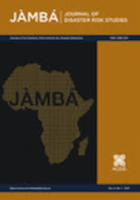
Jamba-Journal of Disaster Risk Studies
Innovative Research for Effective Risk Management.Jamba-Journal of Disaster Risk Studies, published by AOSIS, serves as a vital resource in the fields of management, monitoring, policy, law, and safety research, with an ISSN of 1996-1421 and an E-ISSN of 2072-845X. Since its establishment as an Open Access journal in 2006, Jamba has dedicated itself to disseminating high-quality research that informs and enhances disaster risk management practices, particularly within the South African context and beyond. With a robust Impact Factor and acknowledgement in the Q2 and Q3 quartiles across critical categories in 2023, Jamba ranks favorably in Scopus, notably Rank #50/109 in Social Sciences (Safety Research) and Rank #218/399 in Environmental Science (Management, Monitoring, Policy and Law). The journal's convergence over the years—from 2013 to 2024—signals its commitment to adapting contemporary challenges in disaster risk studies. Scholars and practitioners are encouraged to explore Jamba as a go-to platform for innovative insights and collaborative discussions that impact policy-making and practical applications in disaster risk reduction.

Progress in Disaster Science
Advancing the Frontiers of Disaster ResearchProgress in Disaster Science, published by ELSEVIER, is a prestigious open-access journal that has been advancing the field of disaster research since its inception in 2019. With an ISSN of 2590-0617, the journal has quickly established itself as a leading resource, recognized for its impact across various related disciplines, as evidenced by its impressive Q1 rankings in 2023 in categories such as Earth and Planetary Sciences, Environmental Science, Geography, Planning and Development, and Safety Research. This journal publishes cutting-edge research that aims to enhance understanding and management of disaster risks, resilience, and recovery processes. Additionally, the journal's accessibility ensures that important findings are disseminated widely, fostering collaboration among researchers, professionals, and students globally. Positioned under the umbrella of critical environmental and safety insights, Progress in Disaster Science plays a pivotal role in shaping the discourse surrounding disaster management and preparedness in today's rapidly changing world.
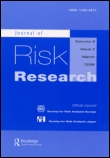
JOURNAL OF RISK RESEARCH
Unraveling the Intricacies of Risk in Real-World ApplicationsJOURNAL OF RISK RESEARCH, published by Routledge Journals, Taylor & Francis Ltd, is a prestigious academic journal dedicated to advancing the understanding of risk across diverse fields, including engineering, safety, social sciences, and management. With its impact reflected in its Q1 quartile rankings in multiple categories and a solid standing in Scopus rankings, this journal serves as an essential resource for researchers, professionals, and students aiming to explore the complexities of risk analysis and its implications in real-world scenarios. The journal has been consistently publishing high-quality research since 1998, contributing to both theoretical frameworks and practical applications. While not open access, the content of the journal is invaluable for those keen on staying at the forefront of risk research. By addressing the multifaceted nature of risk, including safety, reliability, and strategic management, the JOURNAL OF RISK RESEARCH plays a vital role in shaping contemporary discussions and innovations in risk management and decision-making.

Prehospital and Disaster Medicine
Shaping the Future of Emergency ResponsePrehospital and Disaster Medicine is a leading peer-reviewed journal published by Cambridge University Press that targets the ever-evolving fields of emergency medicine and disaster management. With an ISSN of 1049-023X and an E-ISSN of 1945-1938, this journal has established its significance within the academic community since its inception, with coverage extending from 1985 to the present. It is widely recognized within its category as evidenced by its 2023 rankings, which position it in the Q2 quartile for both Emergency Medicine and Emergency Nursing. The journal boasts impressive Scopus rankings, standing at Rank #7/32 in Emergency Nursing and Rank #31/109 in Emergency Medicine, demonstrating its relevance and impact in these critical areas. Although it does not offer Open Access, Prehospital and Disaster Medicine is committed to disseminating vital research and innovative practices that address prehospital care, disaster response, and the intersection of these fields, serving as an essential resource for researchers, professionals, and students alike.
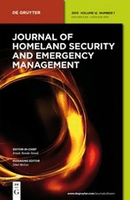
Journal of Homeland Security and Emergency Management
Empowering Resilience in Crisis ManagementJournal of Homeland Security and Emergency Management, published by Walter de Gruyter GmbH in Germany, is a leading platform for scholarly research dedicated to the critical fields of security and emergency management. With an impressive impact factor reflecting its high-quality publications, this journal plays an essential role in advancing knowledge within its scope that covers vital issues such as disaster preparedness, risk assessment, and organizational resilience. The journal's Scopus rankings highlight its distinguished standing, being in the top quartile for Safety Research and demonstrating significant impact across various fields including Business Management and Safety, Risk, Reliability, and Quality. Researchers, professionals, and students alike can access a wealth of information as this open-access journal from 2004 to 2024 is committed to disseminating critical insights and innovative practices essential for effective homeland security and emergency management strategies.
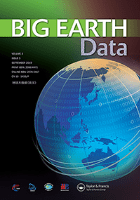
Big Earth Data
Advancing the Frontiers of Earth Science and TechnologyBig Earth Data is a prestigious open-access journal that has been at the forefront of advancing research in the intersection of earth science and computer technology since its inception in 2017. Published by TAYLOR & FRANCIS LTD in the United Kingdom, this journal is dedicated to disseminating groundbreaking findings and innovative methodologies in the fields of Earth and Planetary Sciences and Computer Science Applications. With a commendable impact factor and an impressive positioning in the Scopus rankings—claiming Q1 status in Computers in Earth Sciences and Q2 in Computer Science Applications—it serves as a vital resource for researchers, professionals, and students alike. The journal encourages submissions that explore the integration of big data technologies in managing, analyzing, and visualizing earth-related data, thereby fostering interdisciplinary collaboration. Since embracing its open-access model, Big Earth Data has enhanced the accessibility of high-quality research, promoting a broader dialogue in the scientific community and contributing to informed decision-making in global environmental challenges.
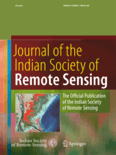
Journal of the Indian Society of Remote Sensing
Unveiling the Potential of Earth Observation ScienceJournal of the Indian Society of Remote Sensing, published by SPRINGER, stands as a prominent contribution to the fields of Earth and Planetary Sciences and Geography, Planning and Development. With an ISSN of 0255-660X and an E-ISSN of 0974-3006, this esteemed journal has been in circulation since 1973, showcasing a rich repository of research and advancements in remote sensing applications, methodologies, and technologies, specifically within the Indian context and beyond. The journal's impact is underscored by its placement in the Q2 category of both Earth and Planetary Sciences and Geography as of 2023, ranking impressively in the Scopus database with significant percentiles. With the intent to bridge the gap between theory and practical application, it invites scholars, researchers, and professionals to contribute innovative studies that enhance our understanding of remote sensing and its implications in various domains. The Journal of the Indian Society of Remote Sensing is a vital resource for anyone looking to remain at the forefront of research in this dynamic field.

Journal of Safety Science and Resilience
Empowering professionals through cutting-edge safety insights.Welcome to the Journal of Safety Science and Resilience, a pioneering platform dedicated to advancing knowledge in the fields of safety, risk, reliability, and quality. Published by KEAI PUBLISHING LTD and based in China, this Open Access journal has made significant strides since its inception in 2020. With an impressive impact factor and a distinguished Q1 ranking in various categories, including Safety Research and Safety, Risk, Reliability and Quality, it serves as an authoritative resource for researchers, professionals, and students alike. The journal's commitment to disseminating high-quality research is reflected in its exceptional Scopus rankings, with top positions in decision sciences and social sciences. As we converge into the future with volumes planned up to 2024, engaging contributions focused on contemporary challenges and innovations in safety science are more essential than ever. Explore groundbreaking studies and elevate your understanding of resilience in the face of uncertainty through this invaluable academic resource.

Australian Journal of Emergency Management
Empowering communities with essential knowledge.The Australian Journal of Emergency Management, published by the Australian Emergency Management Institute, is a pivotal resource in the field of emergency management, public health, and safety research. With a history dating back to 1998 and a convergence period extending to 2024, this journal actively contributes to advancing knowledge and practice in emergency medical services and related areas. Holding strong positions in both the Q2 and Q3 quartiles of 2023 rankings, it stands out within its categories, particularly in Health Professions and Safety Research. While it is not an open-access journal, it provides essential insights and empirical research that are invaluable for researchers, professionals, and students alike. Located in East Melbourne, Australia, the journal ensures that critical advancements in emergency management and health are highly accessible to its global audience, fulfilling its mission to promote informed decision-making and improve community resilience during crises.

Journal of Regional and City Planning
Fostering sustainable development through collaborative research.Journal of Regional and City Planning, published by ITB JOURNAL PUBL, is a pivotal platform dedicated to advancing research in the fields of urban studies, geography, and development. Established in Indonesia, this esteemed journal (ISSN: 2502-6429) serves as an integrative forum for scholars, professionals, and students to explore the complex dynamics of regional and city planning within the context of rapidly changing urban environments. With a commendable Scopus ranking that places it in the Q3 category for Development and Geography and Q2 for Urban Studies, the journal emphasizes quality scholarship aimed at informing policy and practice between 2017 and 2024. Although currently not available in open access, it maintains a solid reputation for its rigorous peer-reviewed articles that contribute significantly to the academic discourse and practical frameworks in urban and regional development. Its commitment to fostering dialogue on sustainable development makes it a vital resource for anyone involved in planning and policy-making.